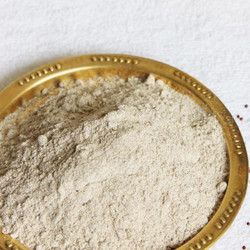Ensure millets are clean without any stones or debris. Wash them thoroughly under running water several times.
Soak them in clear water for about 24 hours. Use a large pot to soak them well. Do not cover the pot, just tie a muslin cloth on the rim. This helps the grains not to turn moldy and smelly since air is circulated through the cloth. Place the pot in a good ventilated place like a window sill or in the veranda. Change the water every 8 hours.
Rinse them well again. Drain them to a colander.
Transfer to a washed sun dried clean cotton cloth. A white cloth is best. If using colored cloth make sure it doesn't release any dye or color.
Bring together all edges, make a very tight knot. The pack should look tight, this helps them to sprout well. Refer the picture above.
Keep it in a steel pot. Cover partially and move it to a dark place for about 20 to 24 hours.
They can sprout anywhere from an inch to 1 ½ inches long depending on climate and the quality of grains.
Open the knot and loosen them, spread on a dry cloth.
one is to dry them in shade for 2 to 3 days in an airy place like a veranda. You will have to keep them inside the house uncovered in the night. This method needs no roasting, the sprouts turn crunchy by the end of second day during the hot days. Second method is to dry roast them on a tawa on a medium flame till they turn crunchy.
If making for babies, making the flour at home is highly recommended. Refrigerate the roasted or dehydrated sprouts for about 2 hours and powder them in a blender jar in batches. Refrigerating helps to powder them well without the blender getting heated.
You can send it to a flour mill as well. You can mill half a kg of rice first and then add finger millet to the mill. Collect the rice flour in a separate pot. Use a different pot to collect the ragi flour. This helps to prevent other flours (like wheat flour) from the mill getting mixed with finger millet flour. Since rice flour is safe for babies, even if it gets mixed its fine.
flour is sieved usually to remove coarse particles. Some folks even sieve it using a thin muslin cloth, if the flour is for babies under 6 to 8 months. Sieving through a muslin cloth also helps to remove hard fiber particles which may cause stomach upset or throat irritation in few babies. But again this needs a lot of patience. You have a elder person like MIL or Mother at home to help you, then you can go for it.
Store the flour in an tight jar glass or steel jar and refrigerate. If frozen it can be used up to a year.
